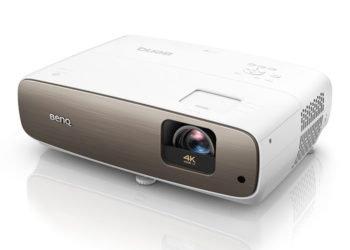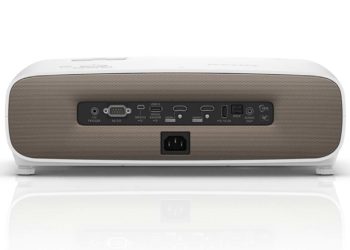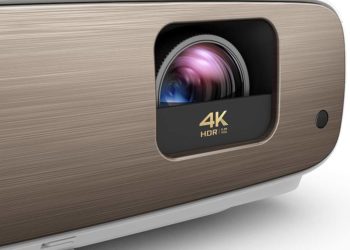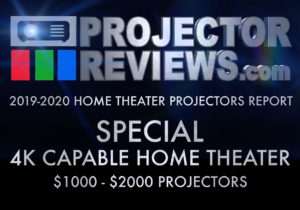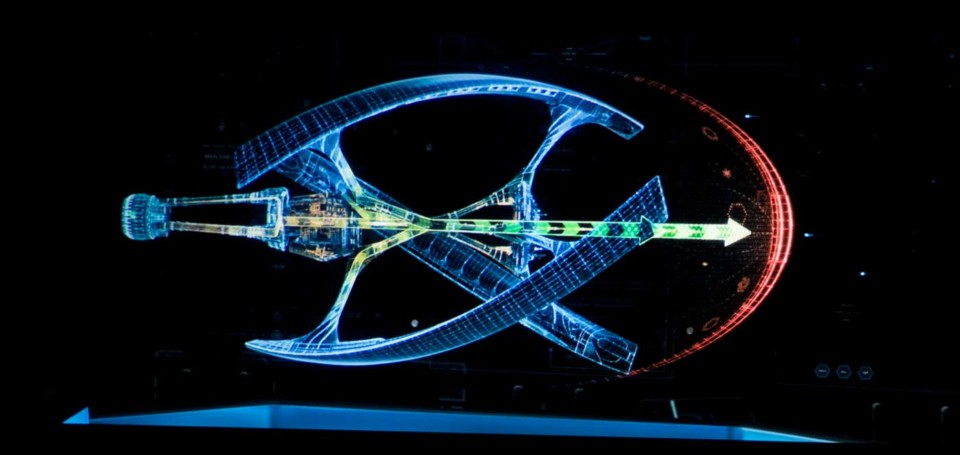When I wrote up my BenQ HT3550 projector First Look Review I had one concern. 4K HDR content appeared oversaturated, and I could never get it right – or close, by playing. No matter, after I wrote up that HT3550 First Look Review, off the HT3550 went to Eric for calibration. There’s more to this story – below. But first an overview.
| BenQ HT3550 Specs |
| Price |
$1,499 |
| Technology |
DLP (1) |
| Native Resolution |
3840x2160 |
| Brightness (Manufacturer Claim) |
2000 |
| Contrast |
30000:1 |
| Zoom Lens Ratio |
1.30:1 |
| Lens Shift |
Yes |
| Lamp Life |
4,000 hours |
| Weight |
9.3 |
| Warranty |
3 years |
Overview
The BenQ HT3550 is a “step up” single chip DLP projector sporting Texas Instruments, “smaller” 4K UHD DLP chip set. The HT3550 projector claims 2000 lumens, which is just slightly less than the lower end HT2550, and even further below BenQ’s “bright room” equivalent of the HT2550 – the TK800, which claims 3000 lumens. The HT3550 projector has a list price of $1499.
This is a projector designed to handle the latest and greatest – that is, 4K content, with HDR – note that the HT3550 supports both HDR10 and HLG HDR schemes.
The first important thing to be aware of, compared to the less expensive HT2550 – which remains in the lineup as a more entry-level projector – is the addition of a dynamic iris to enhance black level performance. But there’s more.
Another definite improvement is the return of modest vertical lens shift, which the HT2550 lacks, but which older predecessor 1080p models like the famous BenQ W1070 did have. Great to have some lens shift again, lens shift is always better than keystone correction for having a precise, rectangular image. There’s an onboard speaker system. Two five watt speakers to be precise, which gives the HT3550 some “home entertainment” abilities.
I might note that the BenQ HT3550 is a relatively small home theater projector and that it is also one that looks particularly good, with clean lines, an off white cabinet with A brown-gray back. The built-in sound, and 9.4 lb. weight (4.2 kg) make it more than portable enough for moving room to room, hauling outside for movie nights (or sports nights, or Game of Thrones – final season – nights. BTW if you do an outdoor movie night, the sound system is adequate, but if you have a more powerful boom box with some real bass, you can use the projector’s audio out.
For those not familiar with the concept, this HT3550 projector is a pixel shifter, its native resolution is 1920x1080, x4 as it fires the same pixel 3 more times, shifting where it hits the screen slightly. A pixel shifter inherently (all else being equal) cannot be as detailed as the bigger, more expensive 2716x1528x2 DLP pixel shifting chipset, and certainly not native 4K. BenQ, like others, tends not to mention those little “resolution” details, (a practice which I don’t care for, but one that seems to be the way many DLP projector makers now describe their 4K UHD projectors). But, not being as transparent as possible, isn’t limited to DLP.
But let’s finish this conversation on the next page.
BenQ claims 2000 lumens. The first unit was very disappointing when measuring brightness. Fortunately, that’s not the case for the full production version I’m working with now, which proved immediately, and obviously brighter!
The important point I want to make is that the HT3550 I have here, looks a whole lot better, right out of the box, than the pre-production unit looked after Eric’s calibration. It was noticeable when viewing 4K HDR content/P3 color.
Some additional basics:
There are two HDMI inputs, as well as a screen trigger and other inputs and connectors. The warranty is three years parts and labor.
A Tale of Two HT3550 Home Theater Projectors - continued
On the first unit, I really don’t think 4K HDR improved in terms of delivering color with the calibration, in fact it probably overall was slightly worse, even if most top end numbers were a bit better. But, at the same time, we also learned that the original HT3550 did not get close to brightness claims, or its P3 color claims either. It certainly seemed to not live up to the specs.
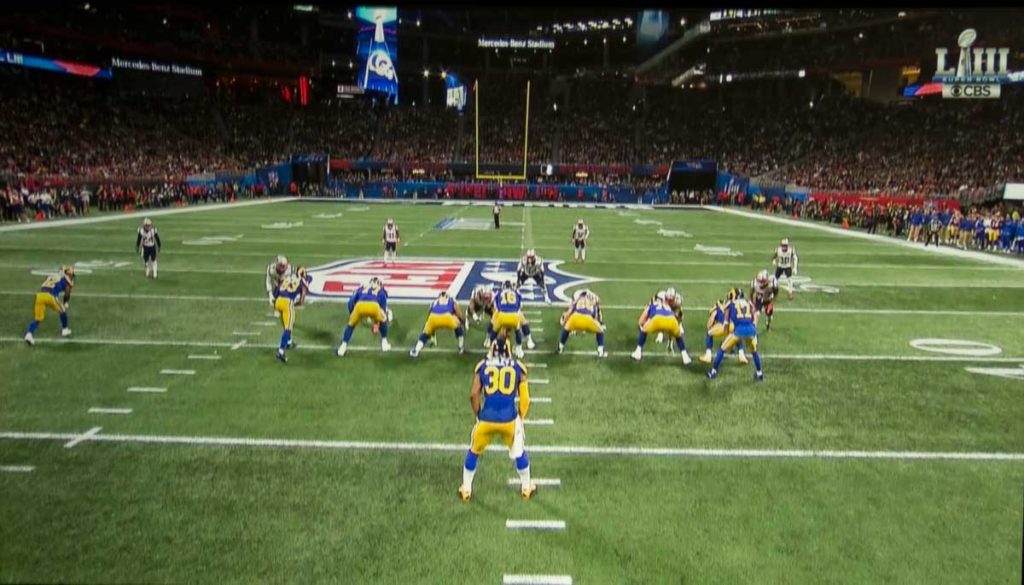
Sports looked really good on this first HT3550, but the newer BenQ that arrived is brighter, and better. The image is very sharp.
I spoke with my usual contacts at BenQ, and sure enough, my unit was one of the first six that arrived (pre-production). BenQ told me that one of the other in this batch may have had similar issues. This is not shocking with pre-production samples.
At that point, BenQ offered a full production unit to complete the review. (the product started shipping days before). I shouted YES! And now I add to that: “What a difference it makes!”
The new HT3550 sits in my theater now – this new one is uncalibrated (other than some simple eyeball adjustments to Brightness, Contrast, and Saturation. And yet, with 4K HDR content, it looks dramatically better than the first unit. I did not have this HT3550 calibrated (I’ve only got budget for one calibration per Home Theater projector.)
In my First Look review, I expressed the hope that the “over the top” HDR would be corrected with calibration, but it took a properly working HT3550 to get that to happen! That said, I'm "paid" to be fussy about such things. The first unit's picture quality - in terms of color, etc. is, no worse than many peoples LCD TVs. It's just that some of us are hardcore enthusiasts, and even a perfectionist or two...
OK, enough about my trials and tribulations relating to having a good looking HT3550 here to review.
Highlights
- 2000 lumens claimed
- Less light leakage than previous models
- Dynamic Iris improves black levels
- Over HT2550 and other entry level DLPs
- Supports both HDR10 and HLG for HDR
- Uses auto tone mapping to best adjust scene brightness
- Offers HDR Brightness control
- Seems reasonably bright on HDR content
- Even on my 124” 1.3 gain screen
- Claims 95% of P3 color with HDR in D. Cinema Mode
- Need brighter image – 97% of REC709 color with HDR in Cinema Mode
- CFI for smooth motion
- Cinema Master suite of image processing controls
- ISF Certified (has all necessary controls to do a proper calibration
- Includes extra “ISF” only modes for calibrators
- Short throw manual zoom lens
- Two HDMI ports (both HDMI 2.0)
- Typical energy saving modes and features
- 3D built in (compatible 3D active shutter glasses required)
- Pair of 5 watt speakers for onboard sound
- Audio out for connecting to bigger sound systems
- This 2nd projector – full production - has firmware 1.0.0
Qumi Q7 LED Projector with 800 lumens - this projector is suitable for portable business and education use, digital signage and for home entertainment. Impressive!
For the most part LED projectors until recently were limited to small pico and pocket projectors mostly with 10 to 500 lumens. There have been exceptions, we've reviewed a few expensive LED projectors in the past 4-5 years, including an LG for $15,000 and a Viewsonic for around $3000, but we're finally starting to see some serious LED projectors in the sub-$1000 price range, ($999 list price in this case), that have respectable brightness.
The latest Qumi from Vivitek is definitely a serious projector. The Q7 projector is bright enough for many business and classroom uses, and is on paper bright enough to produce a 100" diagonal image in a darkened room in your home, for your personal home entertainment, be it HDTV, Netflix, Blu-ray, or Gaming. Resolution is 720p, or rather the "business" resolution of WXGA which is 1280x800, slightly higher than 720p (1280x720), which means it can run 720p natively - no compression. I expect, though that the largest potential for sales of the Q7 will not be for the home, perhaps corporate sales forces or training departments.The SIM2 Nero 3D-2 Home Theater projector is one of SIM2's premium single chip DLP projectors. SIM2 offers their projectors through a collection of higher and high end "dealers". SIM2 is one of those high end companies that stresses customer support and product quality.Optoma's HD8300 projector is Optoma's flagship 3D capable, single chip DLP, 1080p resolution home theater projector. It is built on the HD8200 platform. The primary difference that matters is that the HD8300 is 3D capable as well as being foremost, a 2D projector.Mitsubishi's new HC7800D home theater projector has a manufacturer-suggested list price of $3,499 and it's sold by local installing authorized dealers. The projector itself is DLP based, a single chip design. Read our
First Look at the Mitsubishi HC7800D blog, or read on!Welcome to our in-depth projector review of the Mitsubishi
HC6800 1080p home theater projector.

